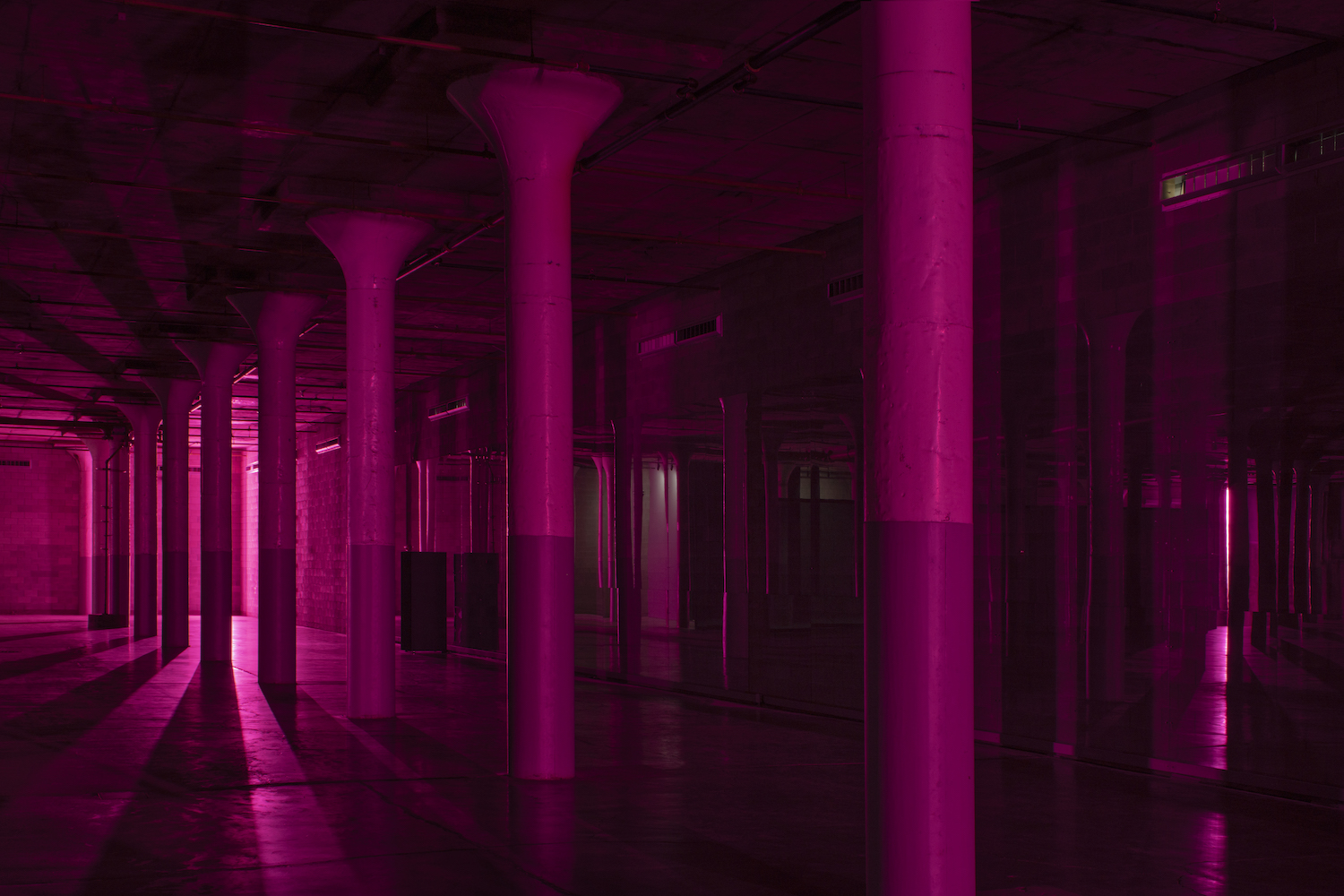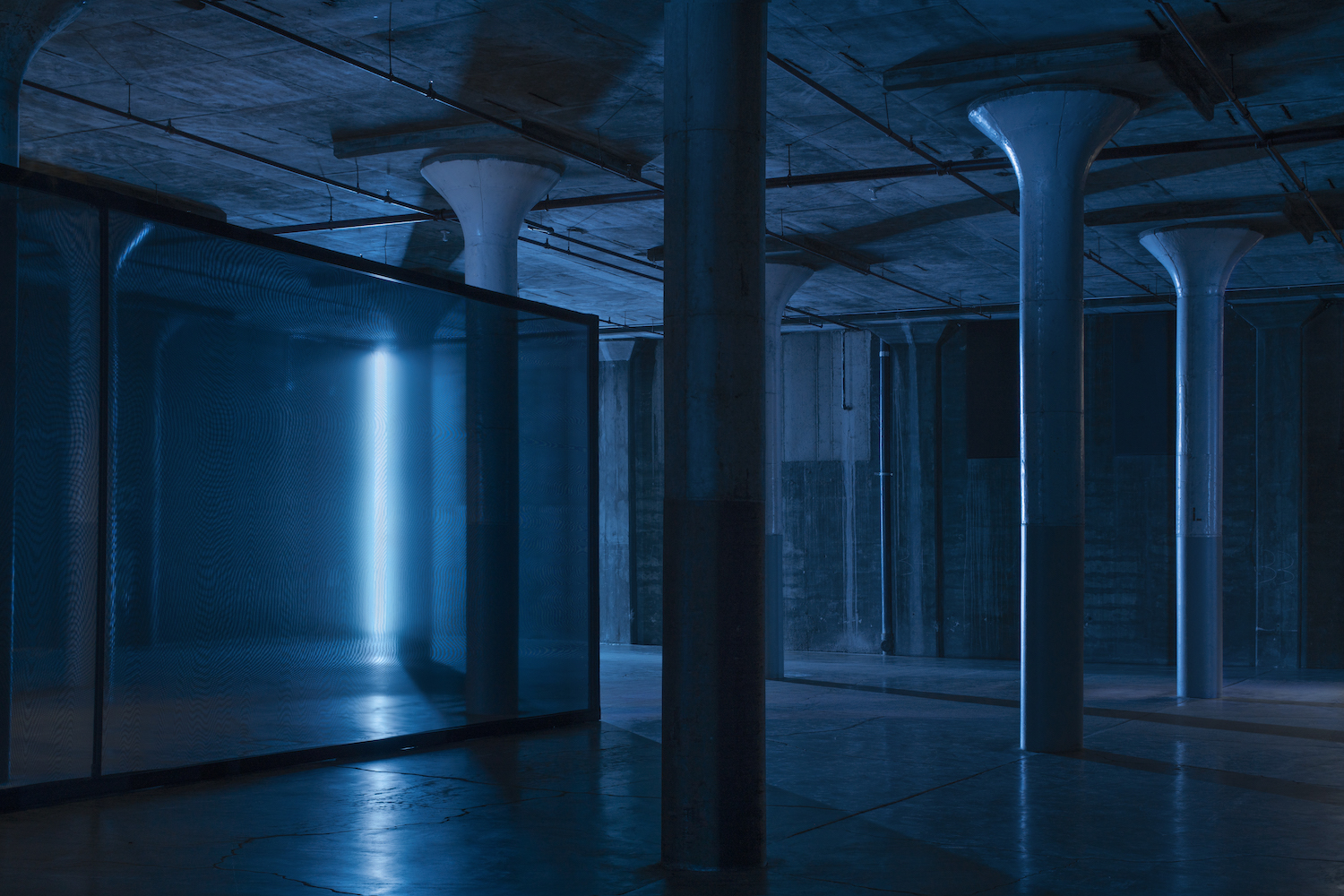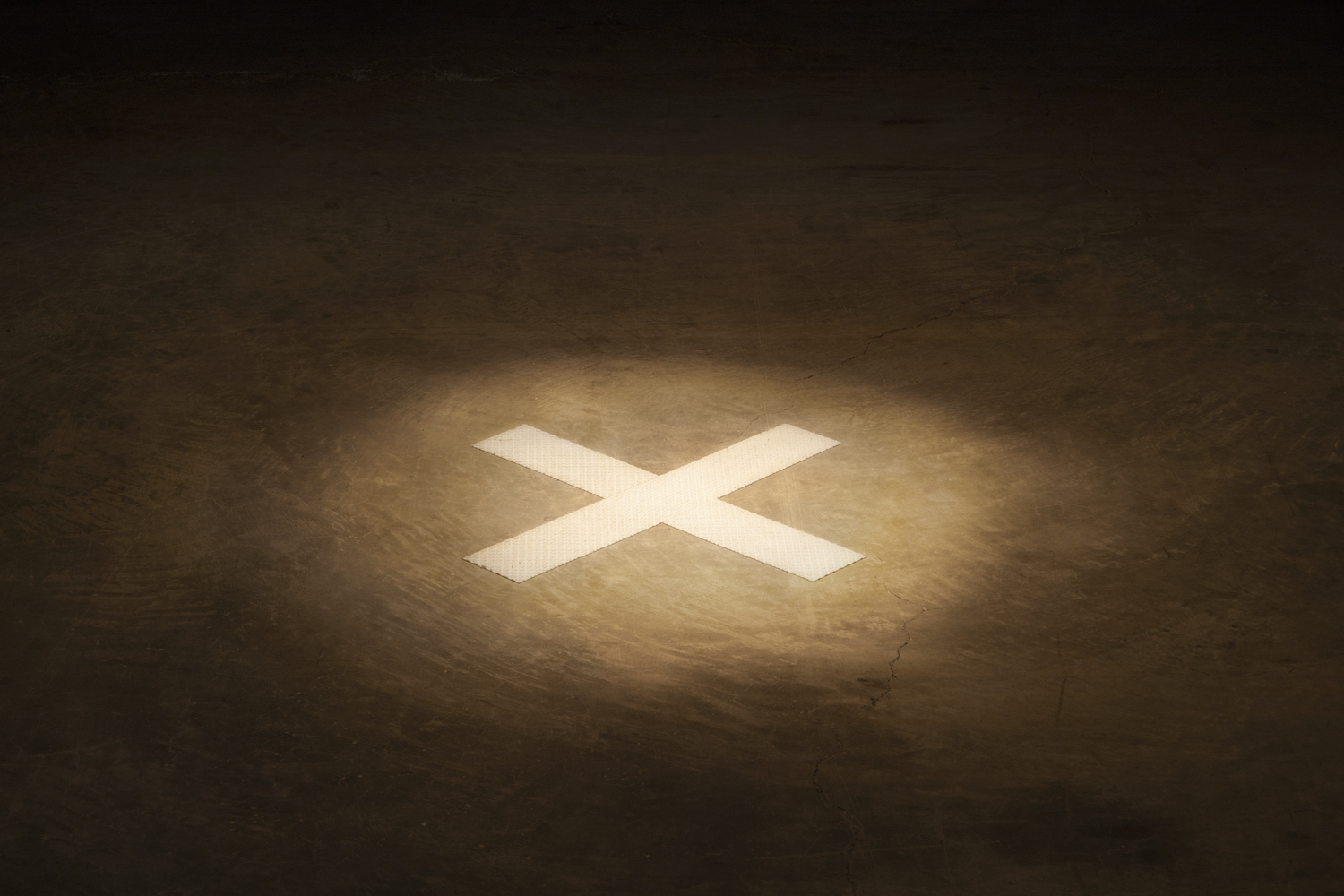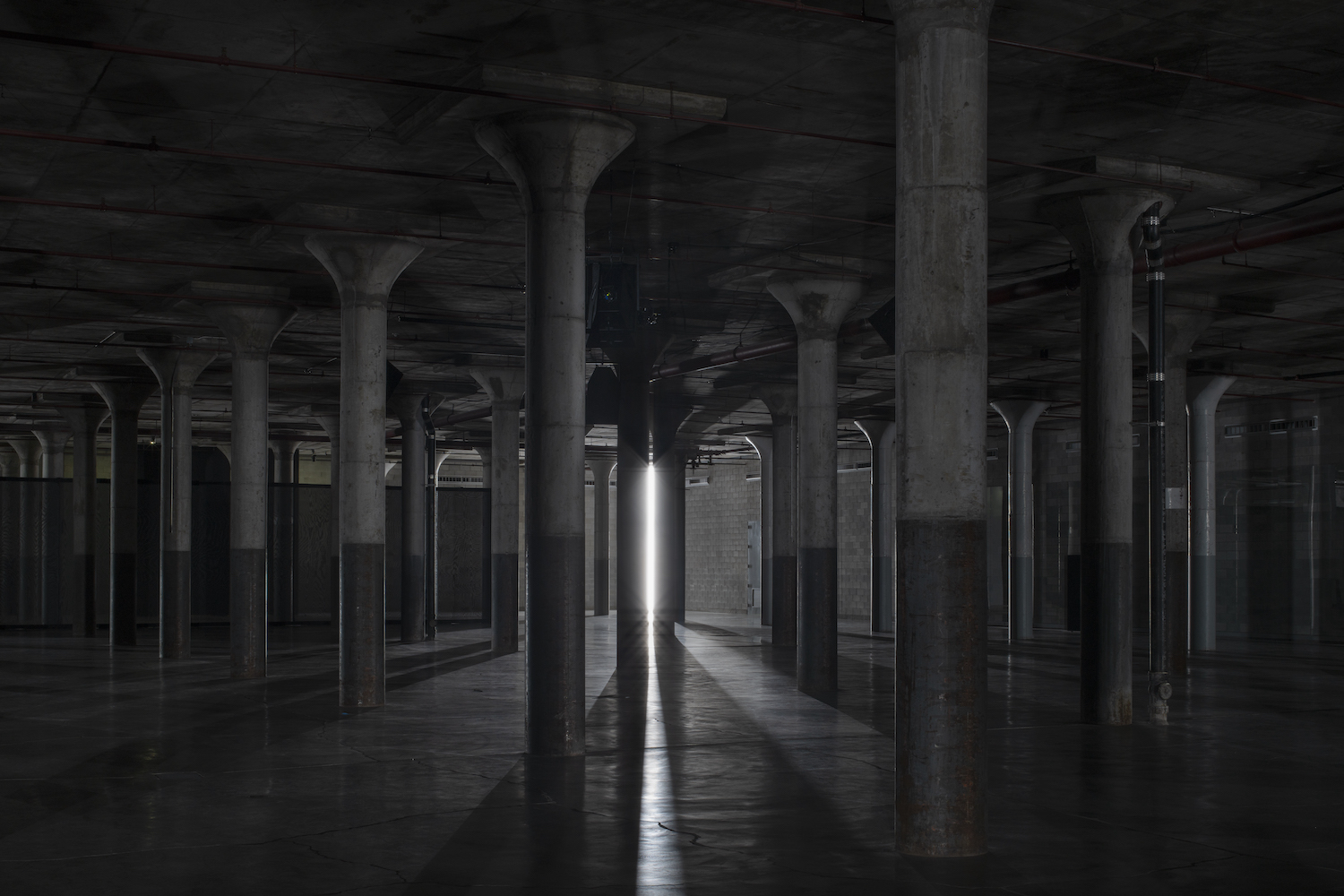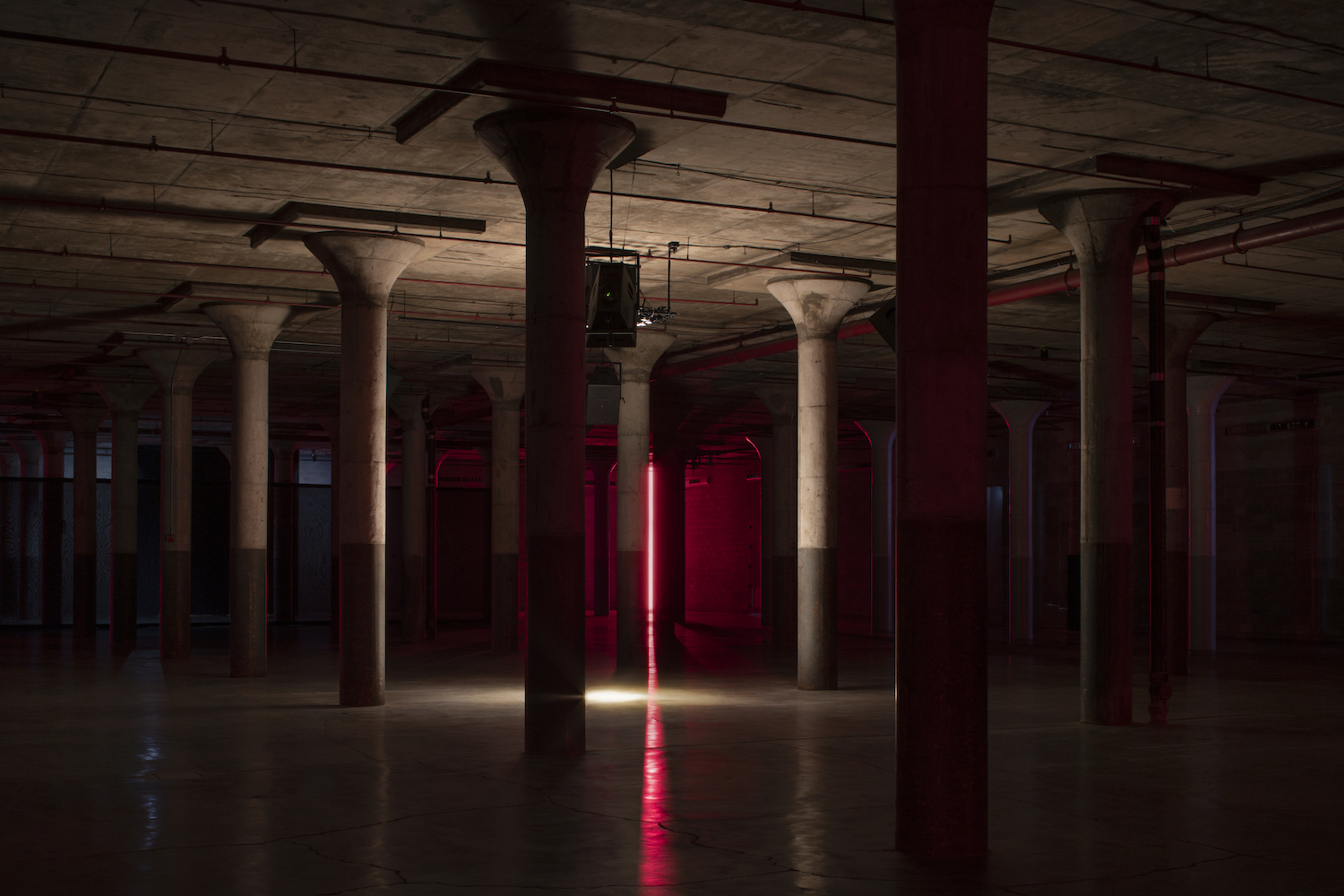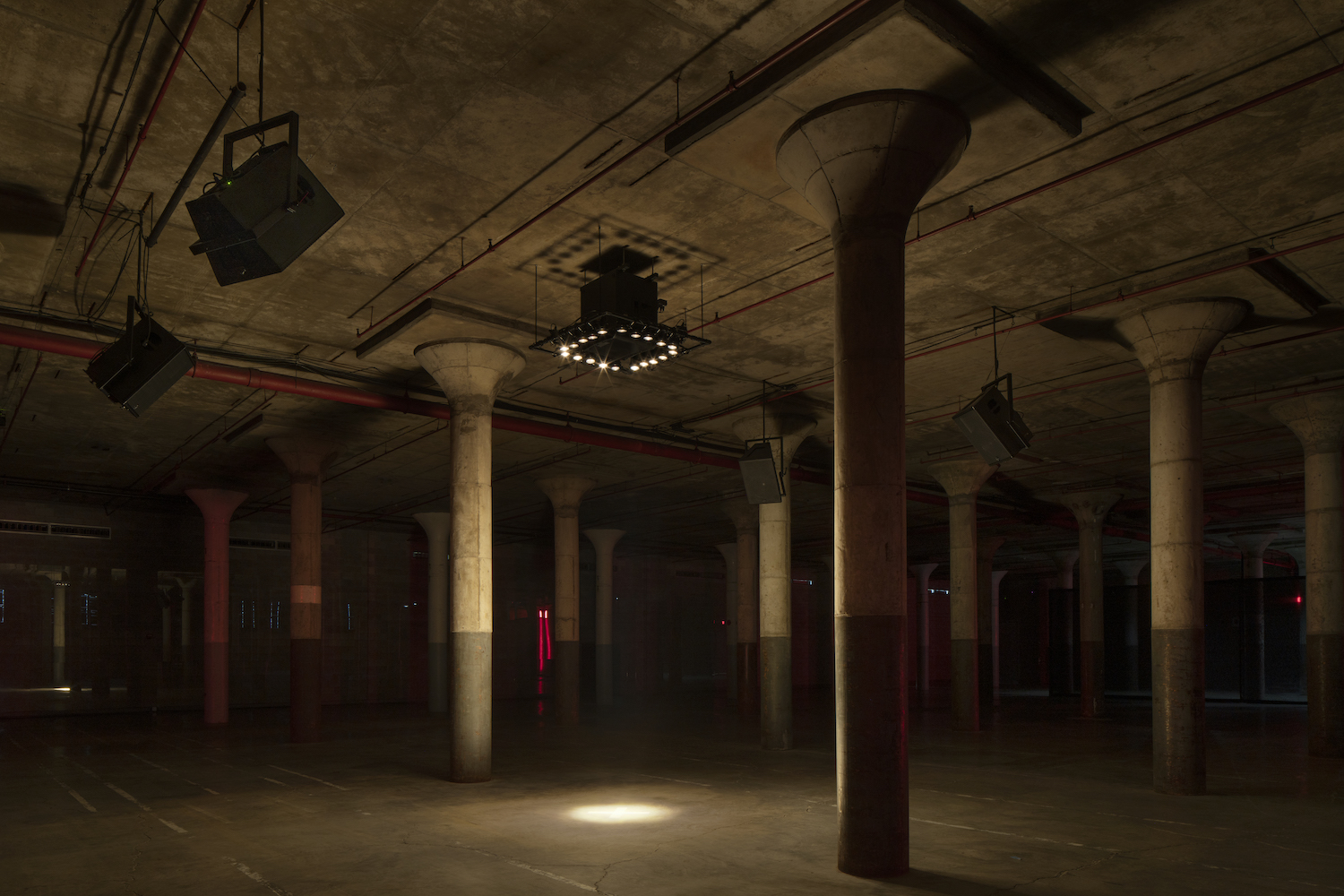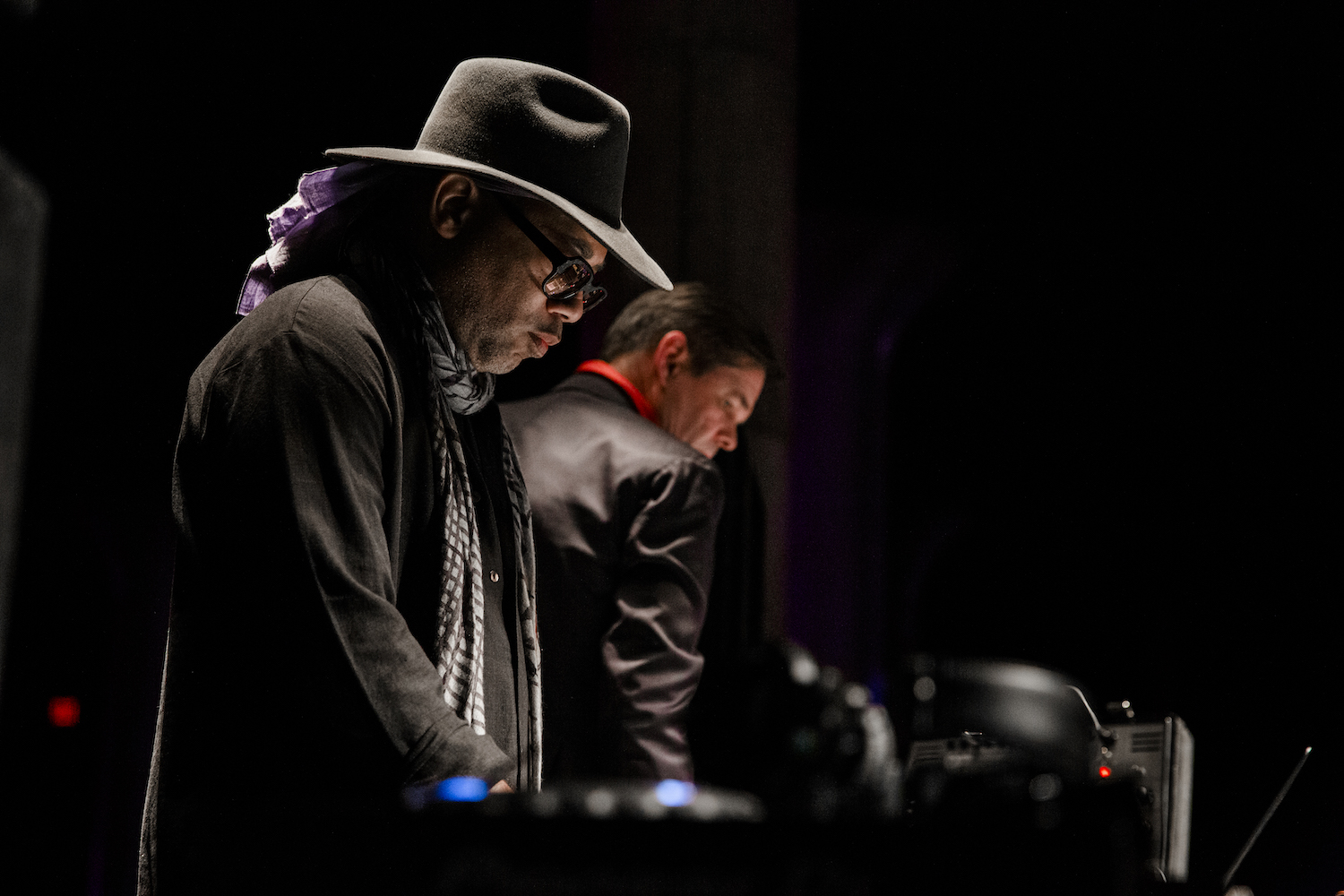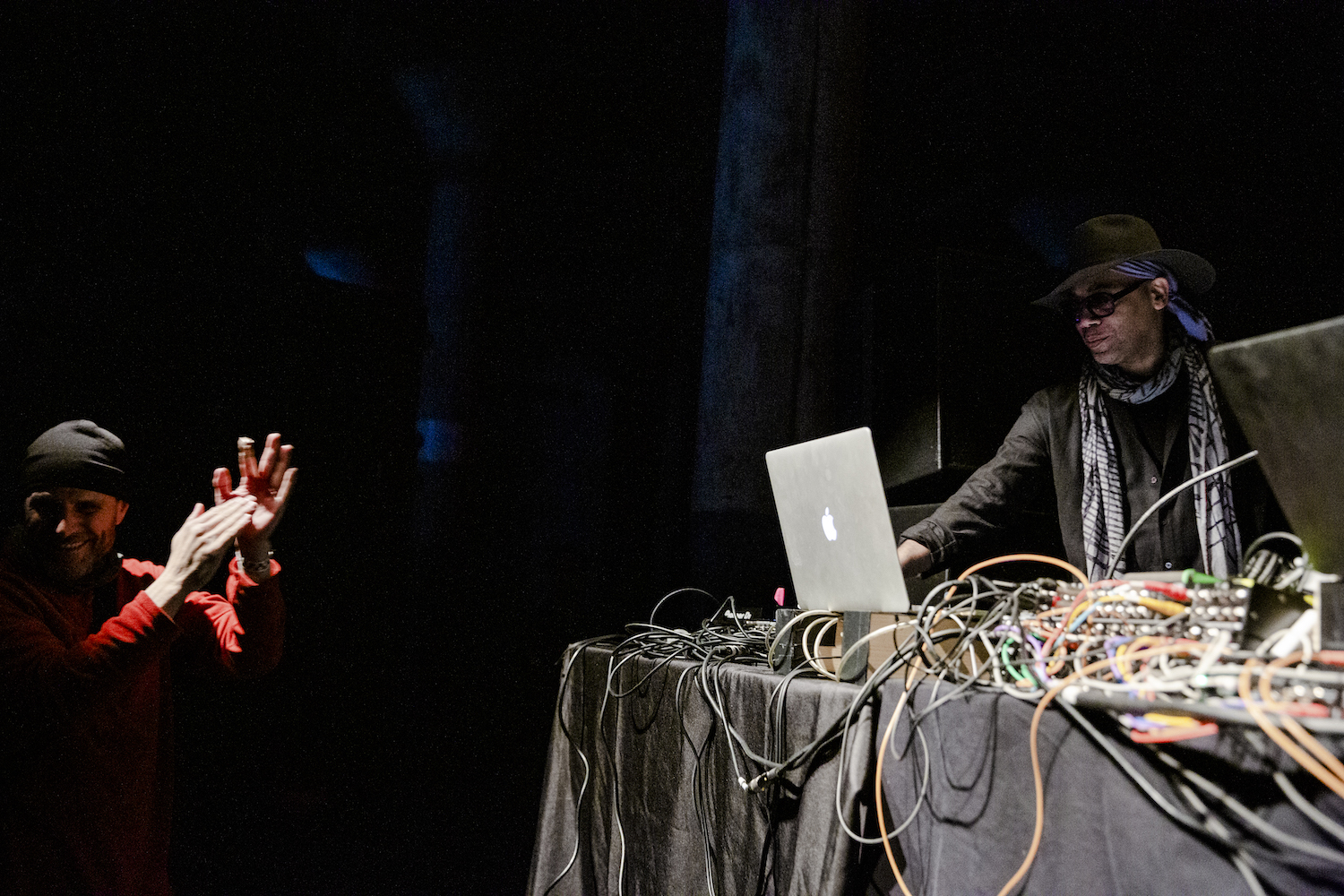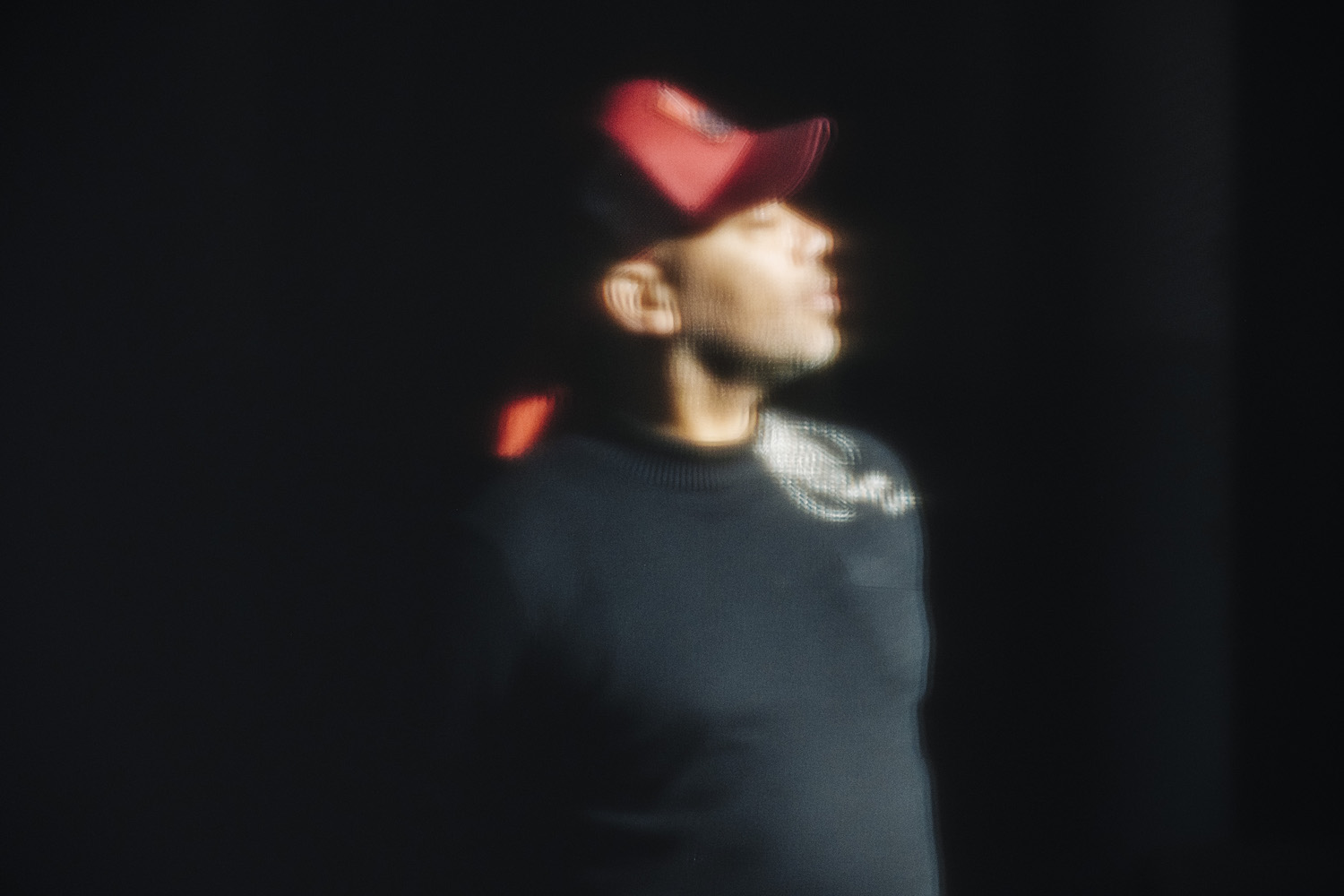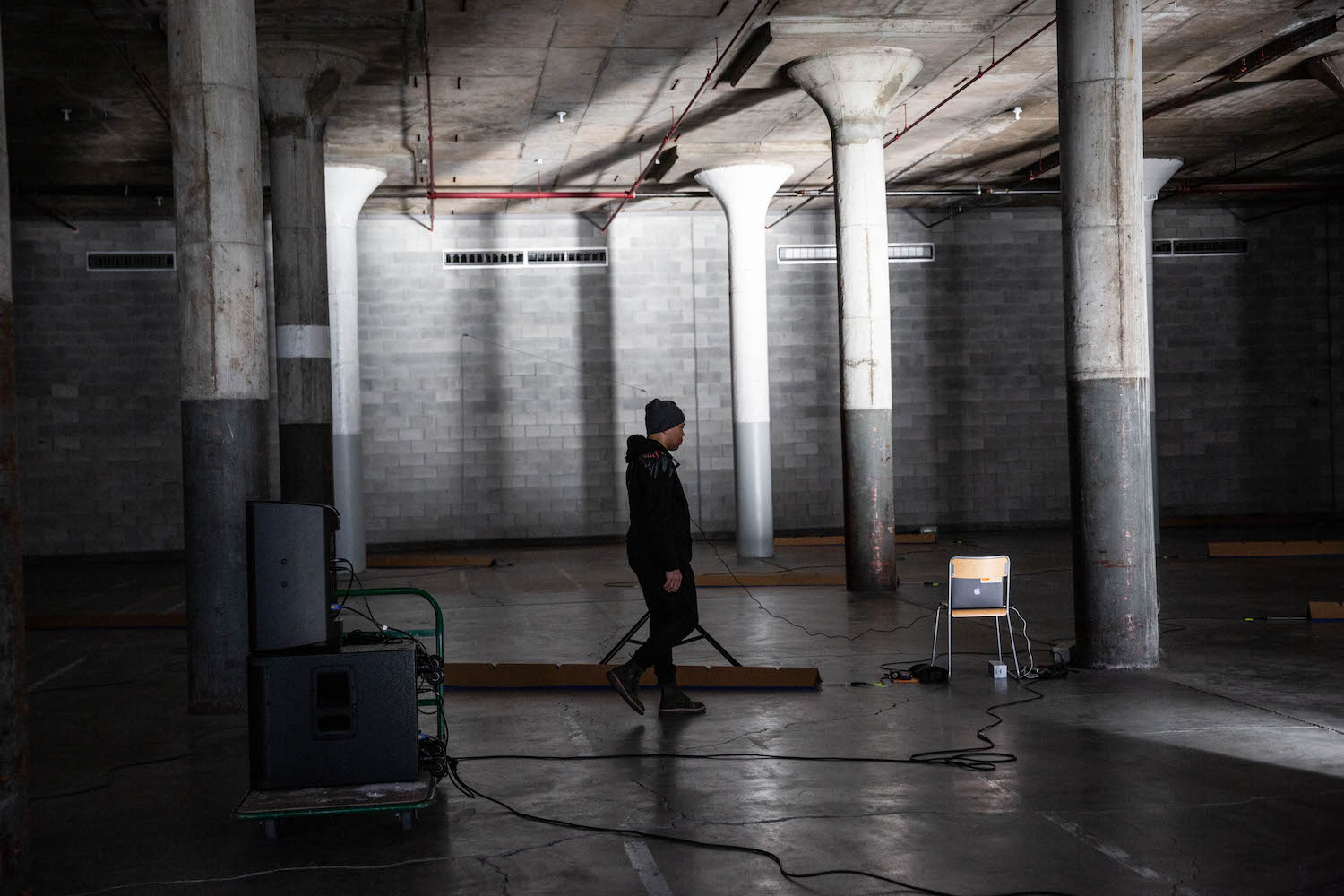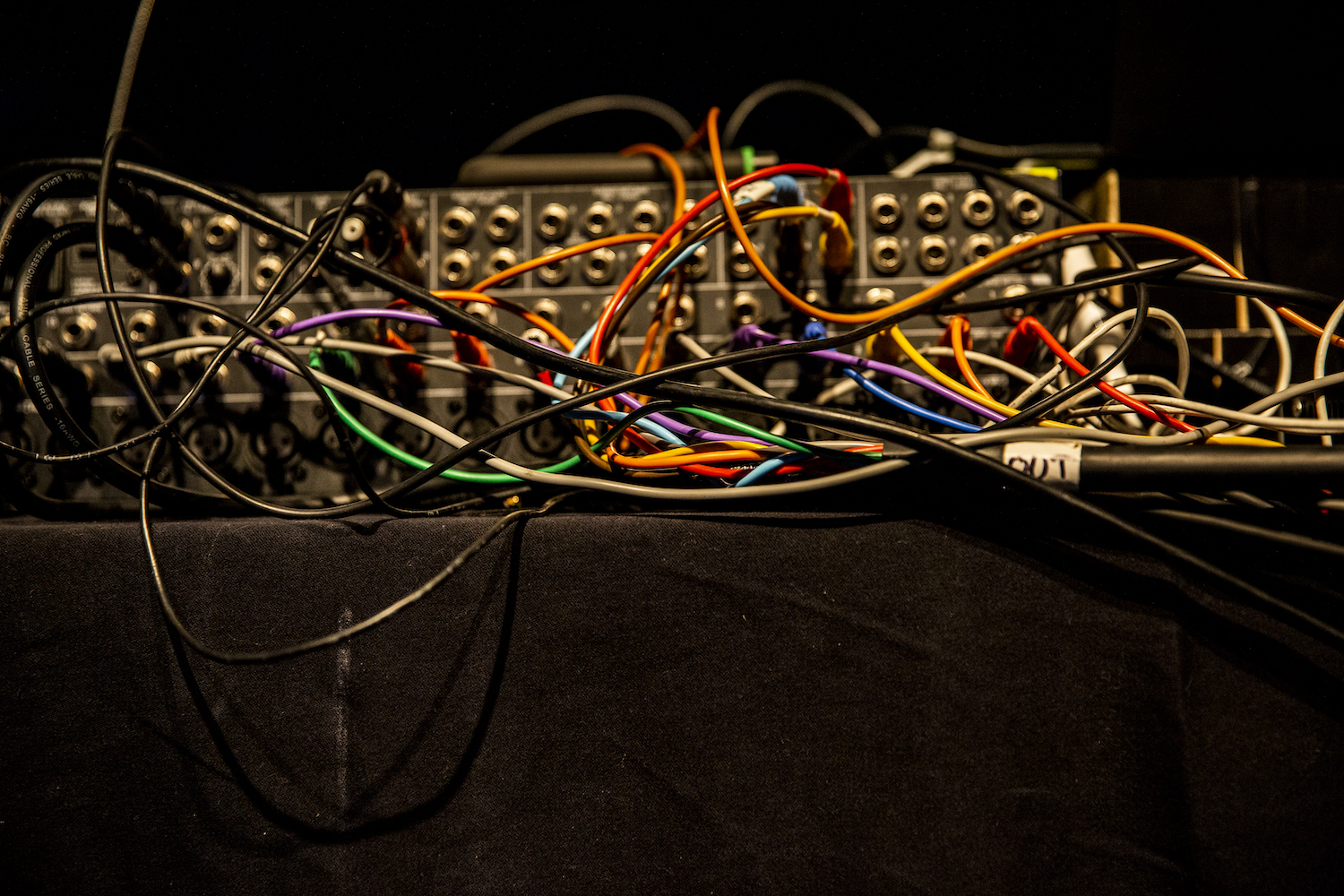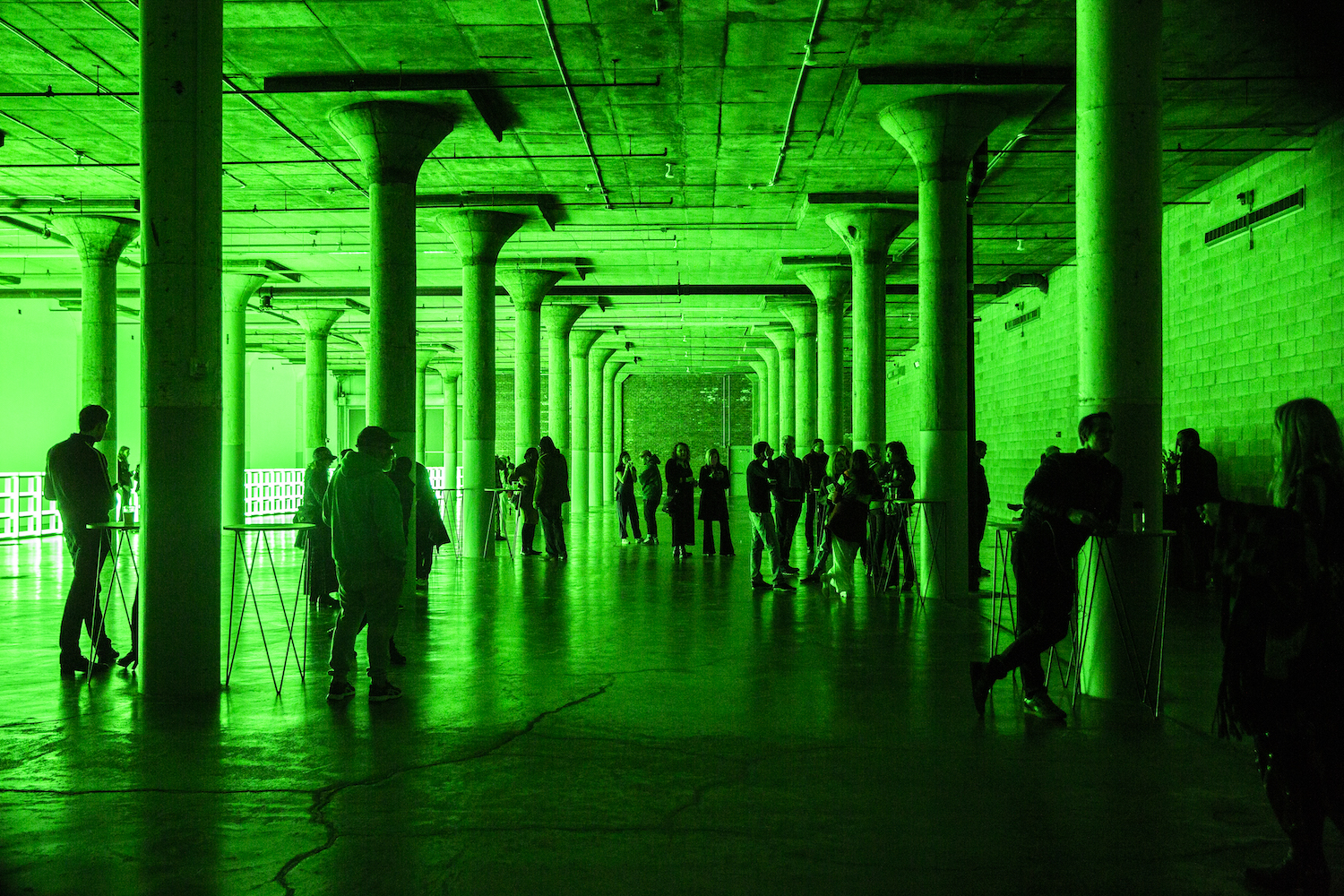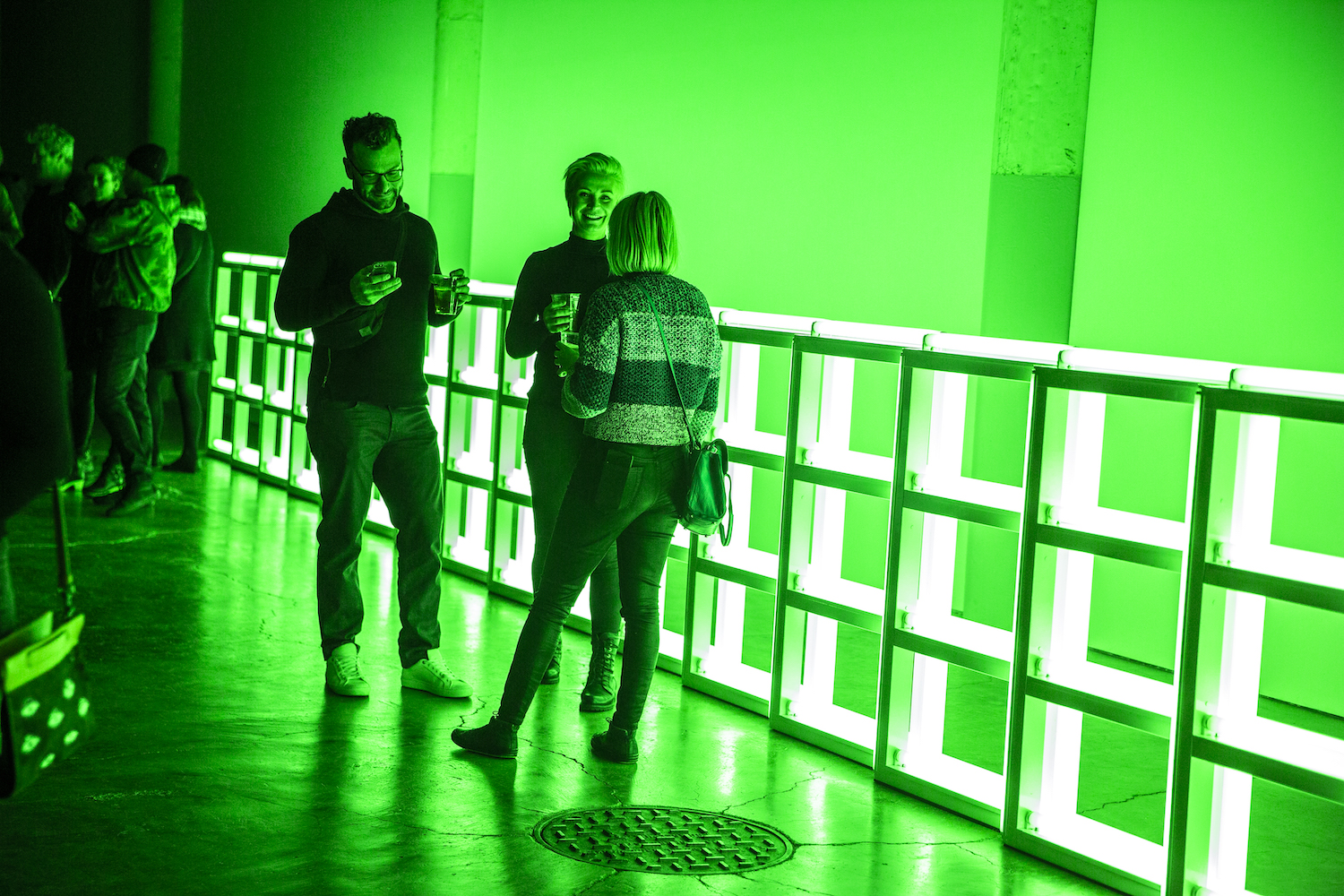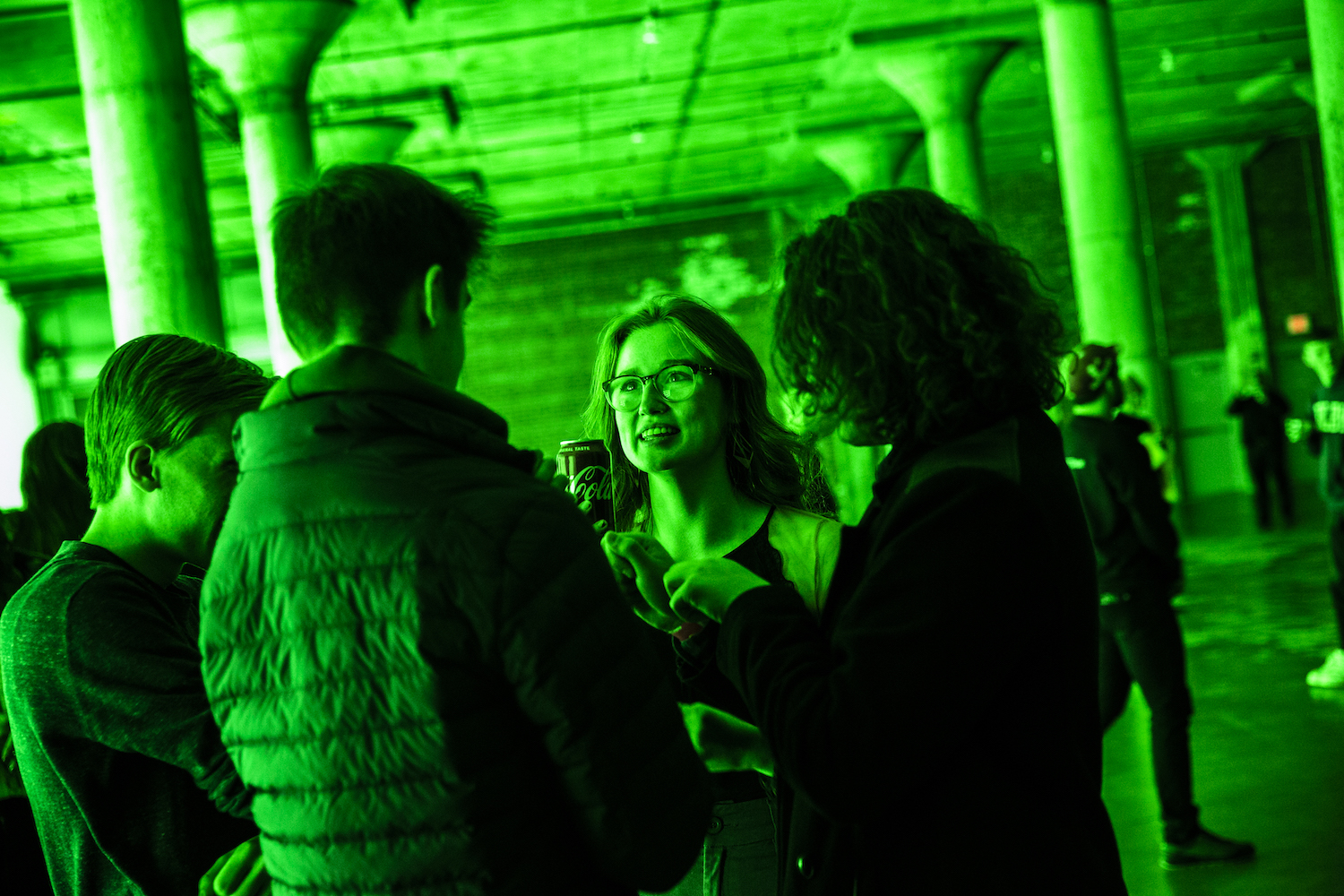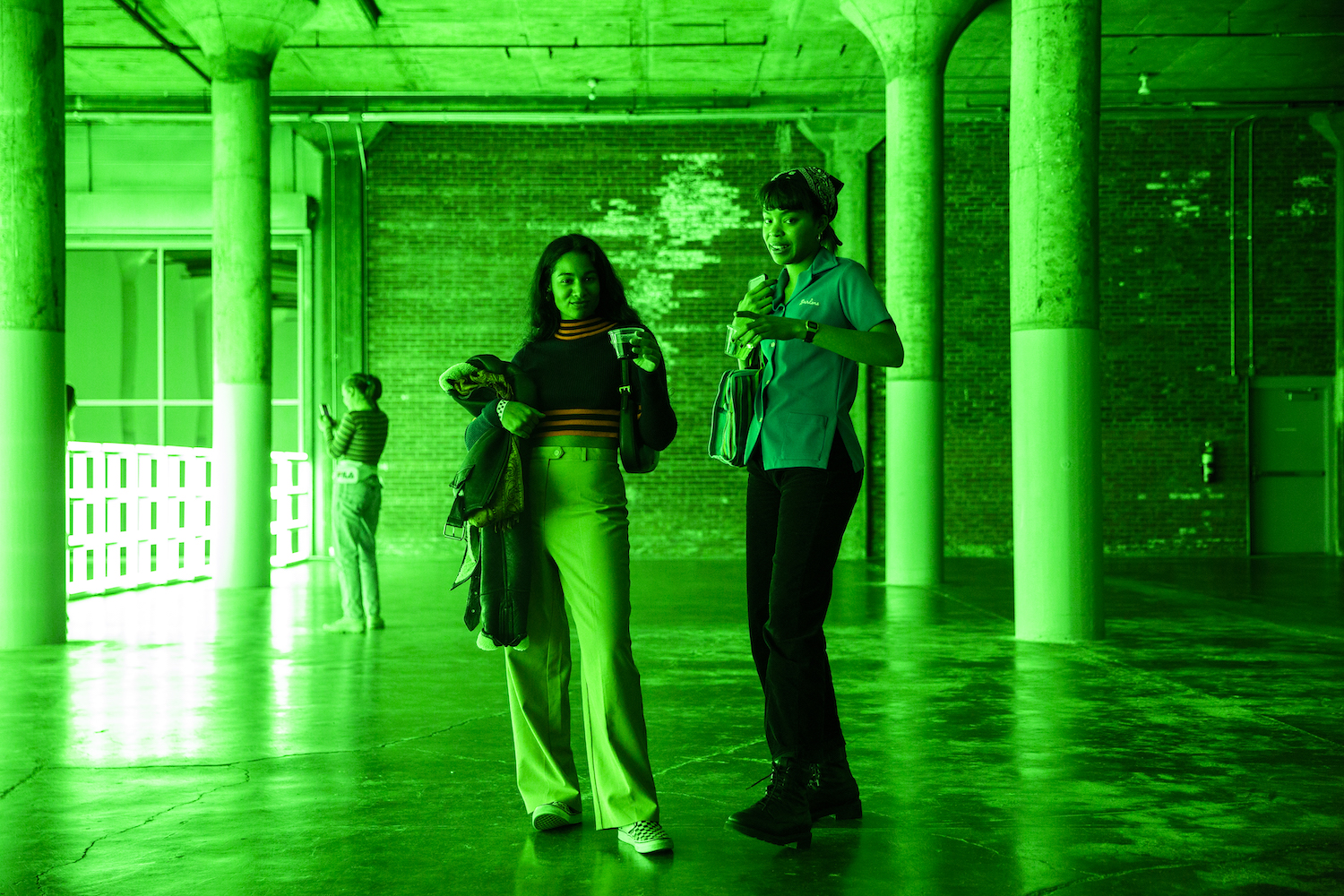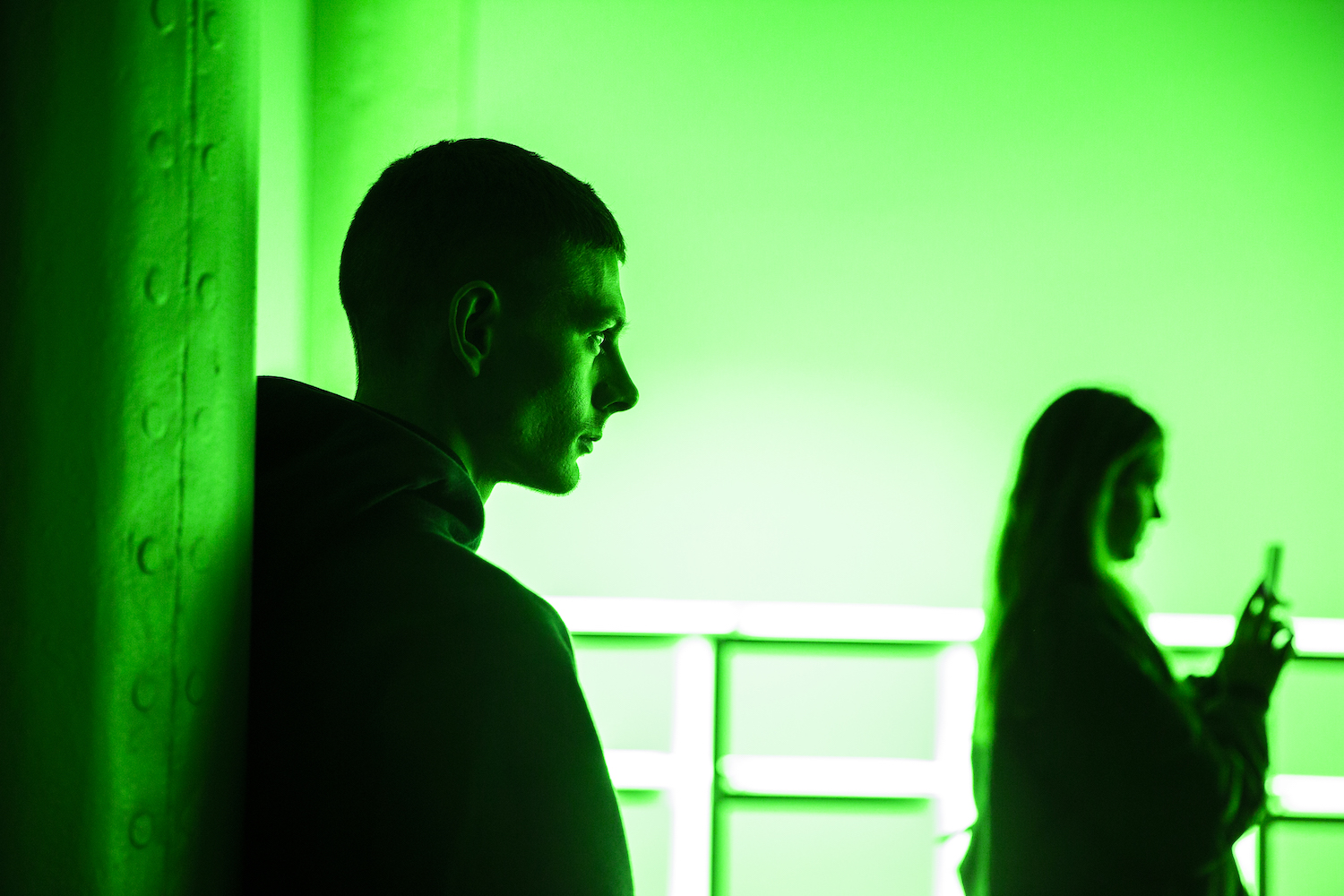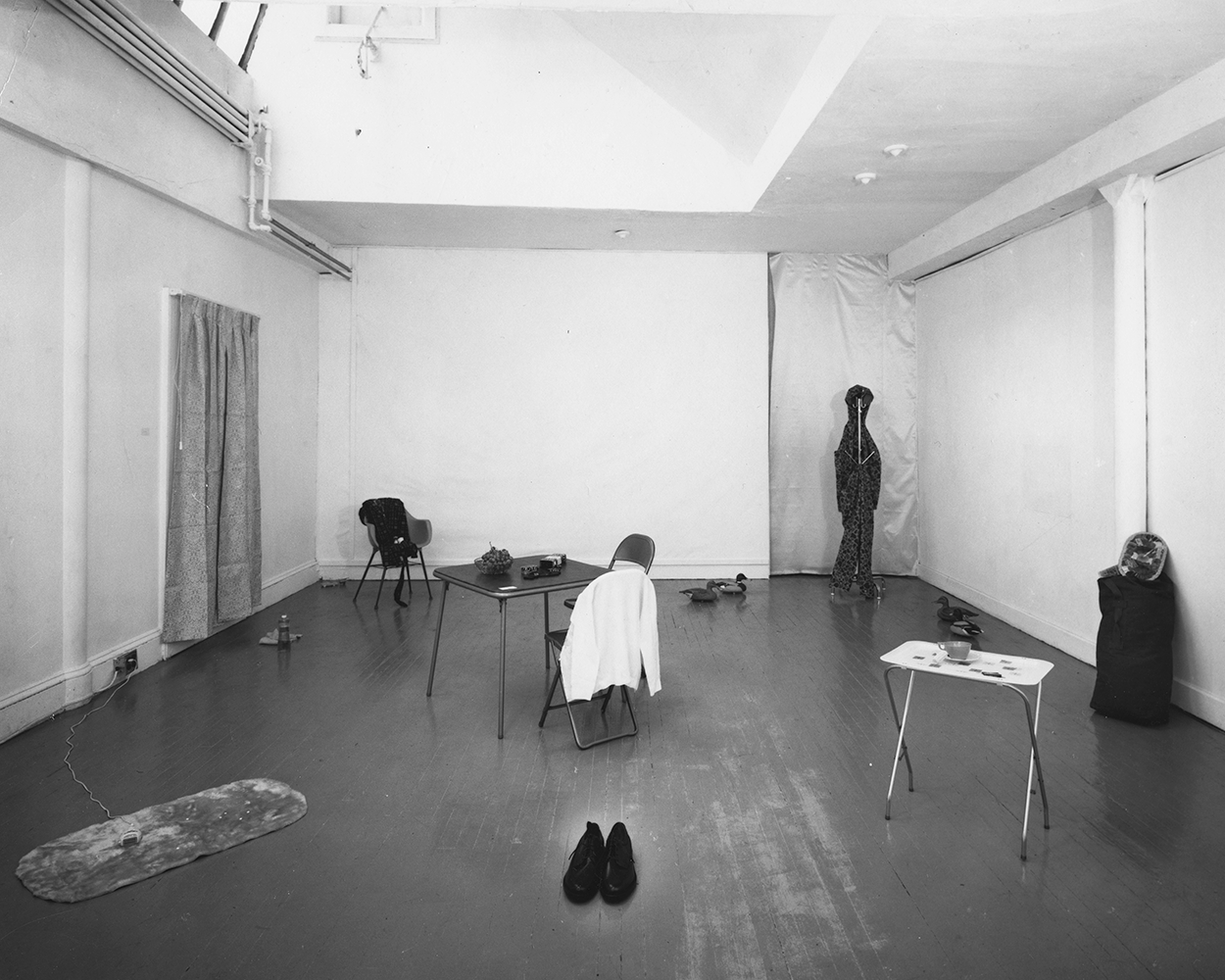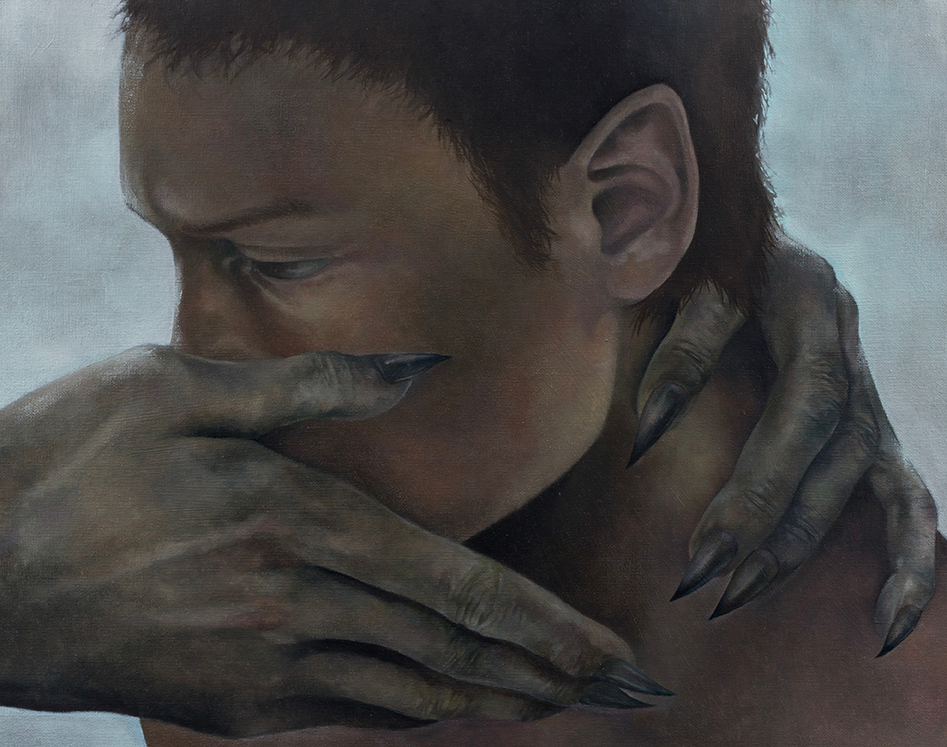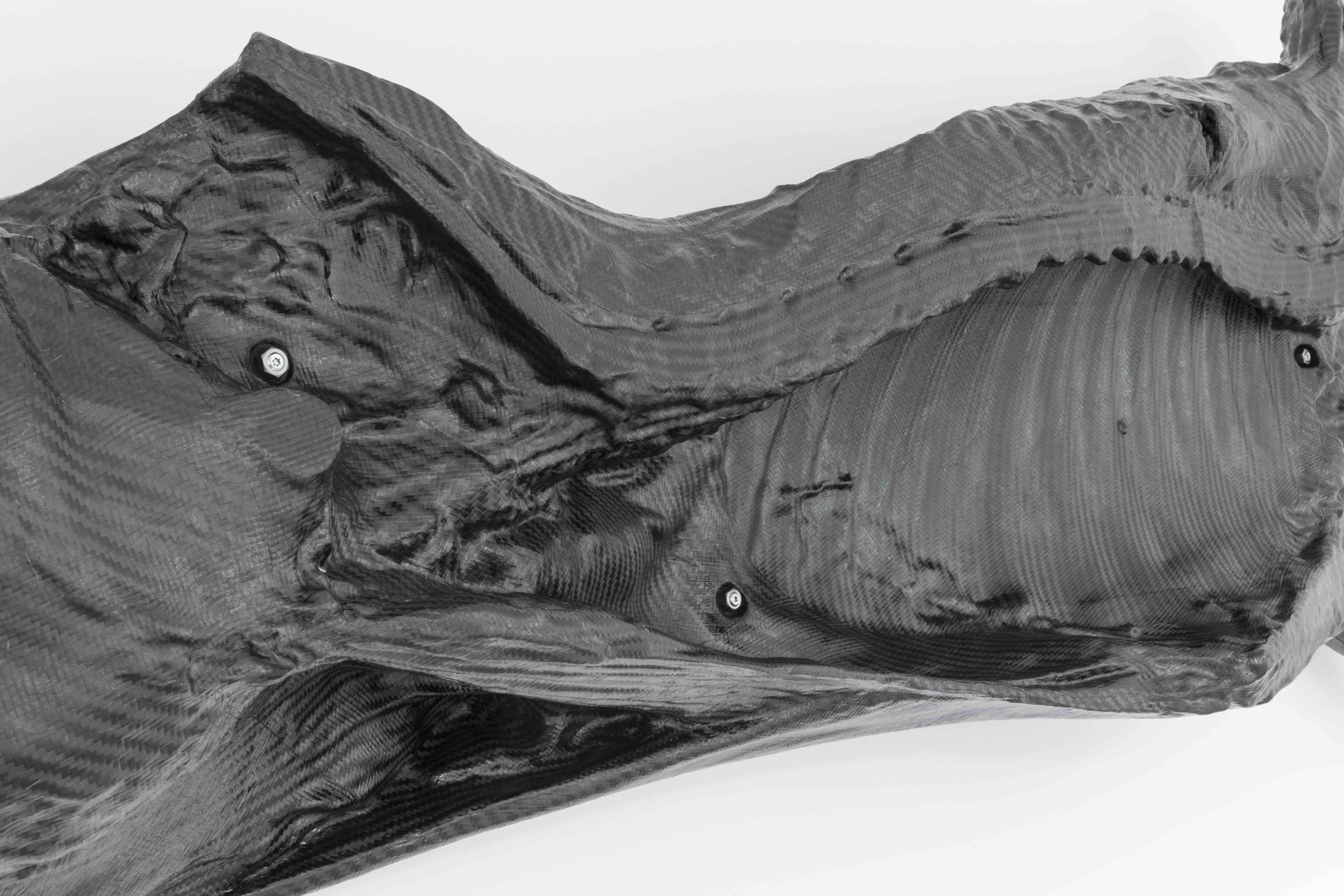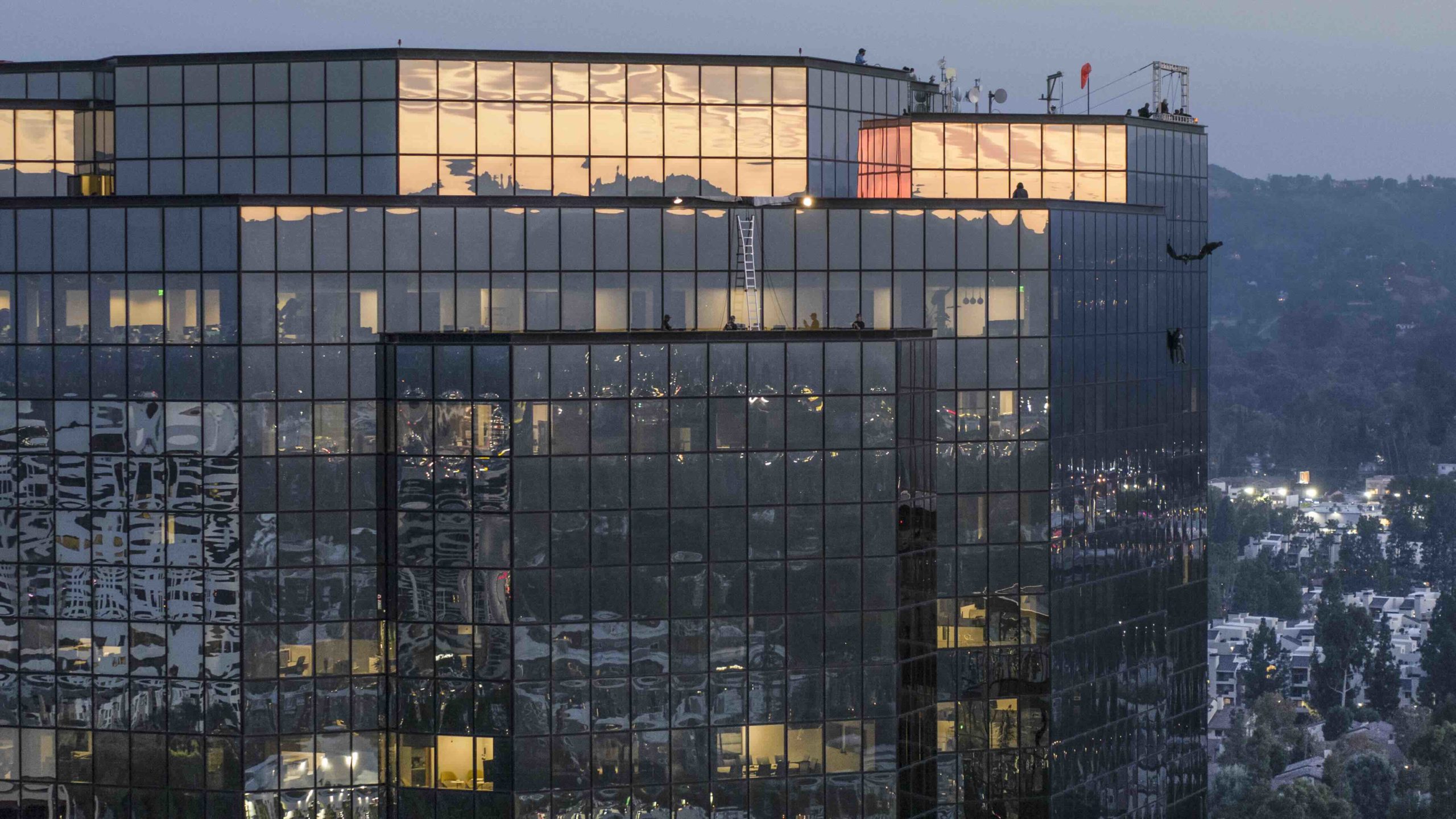“Carl Craig: Party/After-Party” (2020) is an ambitious multisensory installation by legendary Detroit-based musician, DJ, and producer Carl Craig, commissioned by Dia Beacon. We spoke about the process of constructing his installation, his relationship to the world of contemporary art, the impact of the pandemic on musicians and community, and the Black roots of techno music.
Taja Cheek: I just made the trip to Dia to see the exhibition and, as a musician and curator, as a person that used to go to so many shows, to see your work in this moment is really emotional. I wonder if the exhibition shifted or changed in light of COVID-19 or if the current presentation is the way you were always envisioning it.
Carl Craig: That’s how I finished it when it opened, so there was no influence from COVID. But COVID happened and it made the work even more important, so it makes an even bigger statement. It feels more empty now; you can relate that to the streets, especially right when this thing was really hitting and quarantines were going down and every place was like a ghost town. The basement is a vast space. Parties that I’ve played in warehouses all around the country and all around the world —it feels like that when it’s just the sound system and it’s the lights and it’s ready to go, ready for people to come.
That’s an experience that I’ve had a lot, but now people are getting that experience. Because people are used to coming to the party when the action is happening. They’re not coming to the party and waiting for the action to happen.
That’s what I feel as a DJ when I go in to play. If I decide to start first, I’m playing to the club, I’m playing to the room, I’m playing to the waitstaff, the bartenders, the soundmen, or whoever is in the room who is not a party person (yet). When I started making music, I made music to suit my needs, and if anyone had ideas or questions about my music I let that be something that grows with their experiences and their imagination. So, something like a project of mine like [performing alias] 69: many people thought, okay, this is a sexual thing. And it’s actually the year I was born. So there’s always been that kind of double meaning to what I’ve done.
TC: That energy is very palpable in the space, and it’s aided as much by the music as it is the environment you cultivated. I’m curious about the process of putting together the musical composition, and I also wonder how you think about composing the space more generally: the lights are composed, the space is composed. What are the similarities and differences between these different modes of creating, especially from your perspective as a musician?
CC: The music itself I composed for that room — definitely with that room in mind. I sat in the room many times with some select pieces of gear and just tried to get the best idea of what sounds react the best in that space. It has so much reverb: it’s so big and so boomy, especially with certain sounds that have a lot of attack. If you play a pattern of 16th notes and hi-hats, it’s just going to blur the sound.
I had to compose with space in mind, and specifically how those sounds carry into it.
It’s cavernous; if I were to walk into a cave and start making loud sounds with my mouth, it’s going to carry all throughout, and that’s how it is in that room as well. So I had to be very conscious of what type of sounds I use in the room as well as what type of patterns I used because a single pattern could, not even overshadow, but immerse the room in so much sound that it wouldn’t be possible to comprehend what the rest of the music is doing.
TC: The placement of the speakers also plays a visceral role in the experience of the sound too.
CC: Yeah, because there’s speakers not only on the sides of the room but there’s speakers in the ceiling. There’s two types of speakers on the ceiling: the speakers that are for the focal point or the sweet spot, but then there’s an array of speakers that go around the ceiling and that makes it possible for me to send sounds through the room in a sequence, or they could jump back and forth from different points in the room. I did compose what sounds I wanted where, and during the afterparty there’s some voices in the composition, and those voices are composed to randomly go to different speakers in the room at different points.
What is being said are things that I’ve written and posted to Twitter.
TC: I was going to ask about the voices. I tried my best to follow them and understand what you’re saying but it’s difficult to parse out. Is there something in the obscuring of the voice that appealed to you? And is that you speaking?
CC: Yeah, it’s me. It’s the room that actually makes the voice sound maybe not as sharp because, again, even with the voice, s’s and p’s and things like that, the sibilants are going to make the room respond stronger than sounds that don’t have that hardness. So, if the room was smaller you could hear it a lot clearer. But I’m whispering as well, so you have to search out where that sound is coming from; you have to actually be at a speaker when that voice is speaking in order to understand what is being said.
TC: It very much felt like being at a show or being at the club and someone is trying to tell you something, and you’re trying to understand, but the focus is really on the environment and the music, and that takes over instead. I was curious about the connection between your beginnings playing guitar and how and if that filters into the exhibition in some way. I think a lot about the boundaries of what is considered electronic music and how those lines should be blurrier — everything we hear ends up being processed through some sort of electronic channel in some way, and guitars are instruments that use electricity. I was curious if that filtered in a conscious way into this exhibition.
CC: Not particularly in the exhibition but it’s always a part of how I make music. I believe that no matter who makes electronic music, their early experiences with music stay with them. Usually you pick an instrument that you feel comfortable with or that you are attracted to. Like, people who play rock ‘n’ roll or heavy metal or whatever, many times they’re attracted to a certain position in the band based on how many groupies they can get or something. So, I’m going to be a lead guitarist because they can have all the adoring fans, or you want to be the lead singer because the lead singer gets all the ladies, you know what I’m saying? These things stay with you the whole time, whether you’re a kid and you wanted to be Ozzy Osbourne, you’re a kid and you wanted to be Eddie Van Halen, you’re a kid and you wanted to be Max Roach — it’s always going to be there. And I see it with DJs, because with certain DJs, you can tell if they started out as drummers, or if they started out as guitarists, or they started out as bass players.
There’s so many ways that I’ve experienced and seen my colleagues as DJs, as guitarists, as jazz musicians, combine all these influences that they’ve had over time in a way that contributes to how their music is now. And they might not even think about playing that way: it’s just in them.
Those experiences are what come out when I play or when I DJ, but also when I compose music. I start out with chords first instead of drums. And that comes from me learning how to play piano and from teaching myself how to play guitar. So someone who might be more into melody might be a trumpet player first, but people who might have more of a drum-driven thing, they probably had the drum thing happening early in their life.
TC: I think of Blackness in that way too. How it can be expressed through music, reflecting the ways you grow up and the experiences you’ve had. I think about that specifically in regard to techno, and especially because there’s now a younger generation of people that are really intent on making sure that the Black origins of the music are known and felt and continued. I wonder if you feel like there’s a space for techno in particular, but maybe even Black music more generally, to meet this moment of upheaval, of uncertainty, and if you have especially felt or experienced that meeting, that impact, at any point over the past few months of quarantine.
CC: I want it to be at a point where the understanding that this music comes from Black experience is translated very strongly, and I’ve said that in comments over a long period of time. I actually feel that techno needs someone like Little Richard that’s just going to be talking shit the whole time, making sure that you know where the music came from. He was that guy that was saying, “You might think it comes from Mick Jagger and The Beatles or whoever, but they got it from me!” And it’s needed. I think enough people have said it, and
I think that with this down time that we’ve had from clubs, it’s possible for people to pay more attention. In comparison to just being like, “All I want to do is just go to a club and lose myself, and I don’t care where the music comes from.” Now people really have time at home to read and to hear what people have to say.
People are probably paying way more attention to social media; they’re seeing these opinions and voices and statements, and friends are jumping on the bandwagon.
This is one of the cool things about London back in the late ’80s and ’90s when vinyl was really important. There was this movement when people wanted to know about the music and where the music came from, and it was important to them that they could talk to their friends about it. They were listening to early techno records, copying those records, and copying the music and trying to make it on their own, but they were keeping it all in perspective. This music came from Detroit: Juan Atkins, Kevin Saunderson, Derrick May. This music came from Chicago: Marshall Jefferson, Frankie Knuckles, DJ Pierre. They were just very adamant about keeping it that way, and when it got to the point where record stores were losing their luster, and the vinyl-buying scene was kind of dying down, I think there was a shift that was happening because of that. But again, now, people have the time to research, and have arguments, as well as people jumping on the bandwagon putting black squares on their Instagram saying they’re pro BLM; they have to kind of “prove” that they were pro BLM, especially people in electronic music, by actually acknowledging the fact that this music is something that comes from urban Black music culture in the United States.
TC: There’s so many conversations happening right now in music about where it comes from, who is making money off of which parts of the industry and on which platforms, who owns the venues — just a real scrutiny of all of the systems that musicians and administrators and label owners, the whole ecosystem, fit into.
CC: Yeah, yeah. We needed a breather, and unfortunately it was a pandemic that gave us a breather, but we might as well use it to our benefit on an educational level to be able to absorb the music, you know? The only downside is that it depends on how much music is actually coming out, and how much of that music is good music during this time too. I have noticed that there has been a huge amount of music coming out during the pandemic. I would hope, because there’s time to let everything sink in, that there wouldn’t be such a rush to put out substandard music in order to fill the demand for club music. Because there’s a lot of people following whatever the trend is. I don’t have any problems with tech house; there’s some really good tech house, but there’s people that kept on beating a dead horse with a stick, and just kept doing it. The sound quality had improved in many cases because of technology, but there were a lot of people putting out music that really shouldn’t have been putting out music to be honest, but they were putting it out because they wanted to hear it in the club, or they wanted to hear it when they had a DJ friend that was playing, or maybe a big DJ would catch onto it and play it.
With this time off, I hope those people were able to up their game and actually put out music that makes a statement instead of it just being, again, feeding this desire to make music sound the same.
The music industry has been like that, and I’m sure the art world is like that as well. But in the music industry, going back to Little Richard: Little Richard had a hot record and Pat Boone covered it. You get into rap music and there was the idea that in order to make rap records you had to use an MPC and it had to go through an SSL with Pro Tools. So, everyone got an MPC3000 and Pro Tools, and that’s how you’re supposed to make rap music. Instead of it being: you see a band like The Roots and it’s like, okay, I want to start a band and make rap music. That’s the impression that you should have. If you want to make rap music, I’m going to be like The Roots and be a musician and make rap music, not, I get an MPC and I have a bunch of samples and Pro Tools and all of a sudden I’m a rap artist.
TC: I wonder if we may be seeing this happen with MF Doom in real time after his passing, unfortunately. I was also just reminded as you were talking about your insistence on techno being about imagination, and being a space of possibility and dreaming. That seemed like a relevant component of what you were just saying too.
CC: Yeah, imagination is important. When I started, I was impacted by futurism in movies — it might have been the end of that era: Blade Runner and that kind of stuff before it started getting into fantasy, Lord of the Rings and Game of Thrones. My sister used to make jokes about me as a kid. She said, “When you’re driving, cars will be flying.” That was a normal joke for that time about anybody who was young. Your shit is going to be so far in the future that your car’s not even going to have wheels.
So, that’s how making music was for me — a real necessity to keep the future in mind. And the future that we’re living in now: we have automated cars, like Tesla, and we can connect with just about anybody throughout the world through our telephones in such quick time, and get a photo sent from Timbuktu to you and it takes a sliver of a second, a sliver of a millisecond, for you to be able to get it. We’re really living in the concept of what I grew up thinking that the future is supposed to be, so, what’s the future now?
What’s the future for a sixteen, seventeen-year-old kid who decides they’re going to make techno? What’s the future that they’re seeing, that they’re making music towards? It makes it more difficult for me to understand that because we are living in what I saw then as the future, minus the flying cars and stuff. But, people are trying to make flying cars, they are testing them. So my futurism had morphed into the idea that the most futuristic aspect of my music is that you’ll hear it in thirty years, and it will be able to take you back to the space that I made the music in. To put your head into that space. It’s not like you’ve been hearing my music every day on the radio for the last thirty years like Motown records; I don’t consider that futuristic. That’s more like you’re being nostalgic. My idea of futurism is that it feels new even if it’s thirty years ago. It feels good. It’ll still be ahead of the game in thirty years. That’s always my goal. So that’s not like me trying to come up with sounds like ray guns or whatever we imagine satellites to sound like; it’s basically making music that stands the test of time.
TC: There’s this quote from Amiri Baraka who was thinking about Coltrane that also gets at that idea, in my interpretation of it. Abandoning things that are safe, stepping into the unknown, and understanding that’s always a continual process.
I wanted to ask about your connection to contemporary art. I co-curate and organize the “Warm Up” series at MoMA PS1, and I know that you played in 2006. You’ve been planning this Dia exhibition for five or so years, so you’ve also had a connection to that institution for quite a while now. I’m curious how you interpret your relationship to museums, and how you see yourself fitting into the landscape of contemporary art in a broader sense.
CC: What I do, I try to do it like how I breathe. I make music like I breathe. I don’t make music to fit into a scene. I make techno music to breathe. I made jazz music to breathe. Who in their right mind makes jazz music to try to make money in the twenty-first century? That’s just absurd. It was absurd for people to make jazz music in the ’70s and the ’80s or whatever. But, there’s a lot of great jazz music that came out in those times. So, I make music because it’s in me. Because it’s there. Even when I make remixes for other people, and I’m under a deadline to do it, it’s something that I have to channel from within me and it feels great. And again, my idea is always that my music is going to be something that you can listen to thirty years from now, and it still feels good. With me doing this piece with Dia, it’s something that, as the time went on, it became part of me. And that’s important because I see all these pieces at Dia, and thought, maybe I should try to paint? Maybe I should have some paintings around? No, I’m not trained as a painter. That’s not me. What you have in my piece is my experience. And
I think the best way that I could ever fall into this world is by being me. You have me there in that room. I was talking to Stan Douglas the other day, and I told him, hey man, let me know when you’re going to come, and I can take you on a tour of my mind. Because that’s pretty much what that room is. It’s like my mind. You’re walking in there and you’re actually walking inside of my experiences and my thoughts and everything.
When the shutters open and close in the work, it’s an experience thing. It’s a combination of all of my experiences from traveling around the world for the last thirty years and playing clubs in just about every continent, except Antarctica, on this planet. I’m not trying to be Basquiat. I’m not trying to be Warhol. I’m not trying to be anybody that has done great things before me because that was them.
When you’re a producer, you have to get the best out of the singer — or the guitarist or the drummer — that you can, and by me producing myself, I have to do that too. That’s what the situation is with my piece. As a self-producer, I had to pull out the best that comes from me. Over those five years, spitballing and brainstorming, finally this came together. This is the way to go and it’s the best way to go for me, to try to fit into a system that is established as someone that is not as well-versed as scholars of fine art, who isn’t trained in the same way as sculptors and painters are and whoever else in this world that has been very successful in it. I’m not trying to be Banksy. I’ll never try to be Banksy; Banksy is Banksy. And that’s my experience. Don’t try to be somebody who you’re not. I’m what I am, and that piece is what it is, and this is it.
TC: I’ve been thinking a lot about sound and how it’s typically presented in museum settings. A lot of times, sound is kind of tokenized. There may be a group exhibition with a few different artists, and their only connection is that they all work primarily with sound or think about music. But the reality is, a lot of artists, even artists that don’t think of themselves as sound artists, are often still thinking about sound. If you go into an artist’s studio, they may be listening to music. What are artists dancing to when they go out? More tangibly, how do they soundtrack their video work? And, sound artists have perspectives beyond sound too. It was important for me to see this exhibition and witness you being very specific about your own experiences and your own point of view in a multisensory environment. Musicians aren’t often offered this opportunity in museum settings.
CC: Music is the kind of business where a song is manufactured, and you hope that you can manufacture it a million more times so that you’ll make some money from it. That’s the whole concept of the music business: you put music into some form of media — vinyl, CDs, other things — so that it can be sold. I think in the art world the fact that something will be manufactured maybe takes the value away from it. In comparison, somebody that makes a painting, there’s only one. And then it’s a big hoopla because, if it’s really successful, then there are prints made from that. And then you start seeing it reprinted and you see it in magazines, and you can now see it when people post on their Instagrams. But, it all comes from one piece, and the actual objective is not that it’s going to be manufactured a million times. A song comes, in a way, as one piece, because you have a master tape, but the whole intent is that it’s going to be manufactured.
So, it’s like the difference between Ford and Ferrari. Ford, their intent is that they’re going to sell twenty thousand of a car and that makes it a success. Whereas Ferrari has the intent of making one hundred of a car and then it’s seen as being more artistic and more special, because it’s rarer. They also take a lot of time, and the materials they put into it are different. There’s just a difference of process that makes it so that bringing music into the art world becomes not as special because “blah blah blah.” So, we’re going to put them in a group exhibition and there will be ten artists, and then we can call the whole exhibition techno. And that’s pretty much doing what the music industry does, which is: you put music into a compilation and you sell it that way. A techno compilation. You take ten rap records and you put them together and you say, “This is the sound of Compton,” or something. You take NWA and other artists and you put them together and you put them into a collection in that sense.
This situation is great because it’s not part of a compilation, it’s not part of a group setting. You’re getting my statement, take it as it is. I hope that helps to change the whole way that music is seen within the art world, within galleries. I’m really proud that Dia selected me to do this and that we got together something that is making a statement. Making a true statement.

